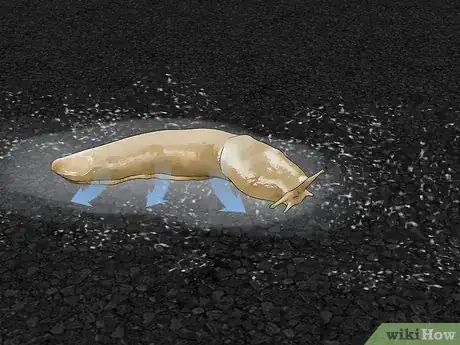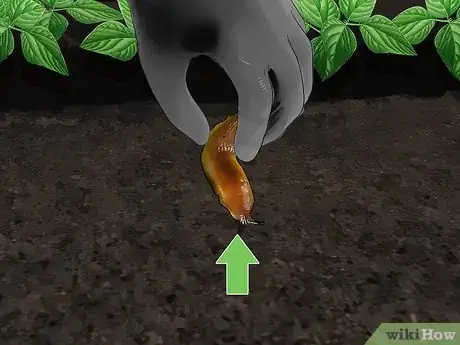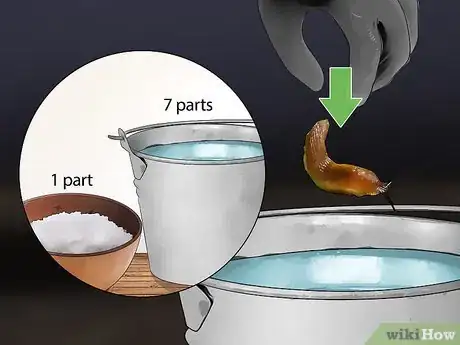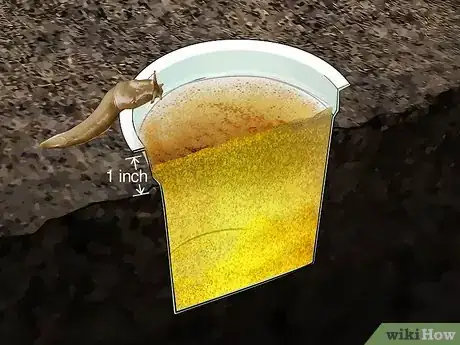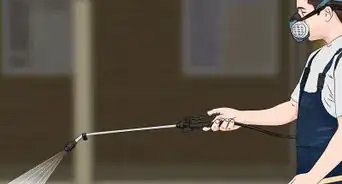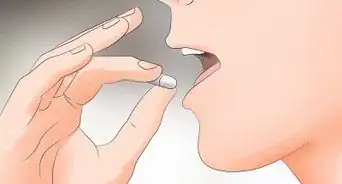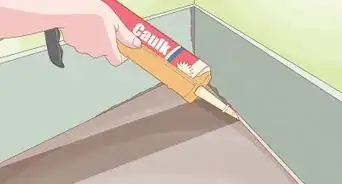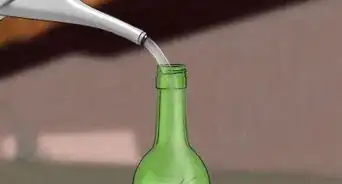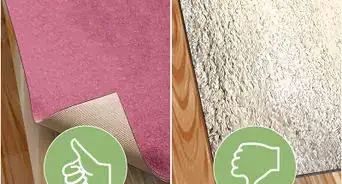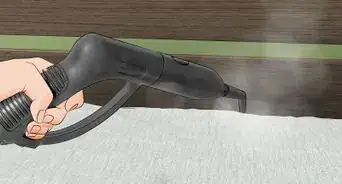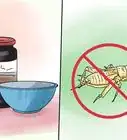This article was co-authored by Melinda Meservy and by wikiHow staff writer, Hunter Rising. Melinda Meservy is a Plant Specialist and the Owner of Thyme and Place, a botanical boutique offering plants and gifts in Salt Lake City, Utah. Before starting her own business, Melinda worked in process and business improvement and data analytics. Melinda earned a BA in History from the University of Utah, is trained in lean and agile methodologies, and completed her Certified Professional Facilitator certification. Thyme and Place offers indoor plants and containers, a fully stocked potting bench, and tips on plants to suit your space and lifestyle.
There are 13 references cited in this article, which can be found at the bottom of the page.
This article has been viewed 24,877 times.
Have you noticed shiny trails of slime in your home or on the plants in your garden? If you’re also seeing irregular-shaped holes on plant leaves, you’re probably dealing with some garden slugs. You may have heard that salt works great for killing slugs, but you should know a few things before trying it out to see if it’s the right choice. We’ll give you the answers to some of your most common questions and more to keep your home and yard slug-free!
Steps
How do I get slugs off my plants to salt them?
-
1Leave a board on damp soil overnight to make a hiding spot for slugs. Water a patch of soil in the late afternoon and set a piece of wood or cardboard on top of it. Make sure there’s some space between the board and the ground by setting it on top of a brick or stone so slugs can get underneath. Just be sure it stays close to the ground so slugs can easily reach it. The next morning, flip the board over to find a bunch of slugs hiding there. After that, you can pick or scrape them off.[5]
- Slugs need somewhere to escape from the sun, or else they’ll dry out.
-
2Go out and hand-pick the slugs at night. Go out to your yard in the late afternoon and water the plants where you’re having a slug problem. Wait until it gets dark and go back outside with a flashlight and gloves. Search the undersides of leaves for slugs, and just pull them off by hand to collect them.[6]
- If you don’t have gloves or don’t want to pick the slugs up by hand, use a pair of tongs instead.
How do I use salt on slugs?
-
1Sprinkle the salt directly on slugs to stop them in their tracks. You can use any type of salt on the slugs. Whenever you have a slug away from your plants, just take a pinch of salt and put it directly on the slug. The slug may start writhing around or making more slime, but that’s normal. Within a few minutes, the slug will dehydrate completely and die. After the slug dies, collect it in a bag so you can throw it away.[7]
- Since slugs make a lot of slime while they die, it could leave a mess on the floor or ground. It’s best to use salt outdoors away from any plants or surfaces you want to keep clean.
-
2Drop slugs in a saltwater solution as you find them. Fill a plastic container that has a lid with a mixture of 7 parts water and 1 part salt. Whenever you find a slug, drop it in the mixture and close the lid. Leave the slugs in the mixture for at least 2 days before throwing the container away in a plastic bag with your regular trash.[8]
- Avoid adding slugs to compost since they could contain a dangerous rat lungworm parasite.
What other ways can I kill slugs without salt?
-
1Put a beer trap down to attract and drown the slugs. Fill a deep bowl or container with beer and bury it in your yard so at least 1 inch (2.5 cm) sticks up above the ground. The fermented smell of the beer attracts the slugs, but they’ll fall and quickly drown in the beer overnight. Check the container the next morning and empty it if there are slugs inside.[11]
- Be sure to refill the beer every few days so it stays fresh.
-
2Apply nematodes to the soil to infect and kill the slugs. Beneficial nematodes are small microscopic creatures that live in soil and infect pests with bacteria. Get nematodes from your local garden supply store and mix them with water following the directions on the packaging. Starting in spring, apply the nematodes in the evenings when the soil is warm and moist.[12]
-
3Try feeding slugs bran so they plump up and get eaten by birds. Sprinkle some pure bran in the soil around your plants so the slugs stay off your leaves. When slugs eat bran, they swell up and slightly dehydrate so it’s harder for them to move. Birds will see the slugs struggling to get away and get a free and easy meal.[13]
Expert Q&A
-
QuestionHow do I keep snails out of my garden?
 Melinda MeservyMelinda Meservy is a Plant Specialist and the Owner of Thyme and Place, a botanical boutique offering plants and gifts in Salt Lake City, Utah. Before starting her own business, Melinda worked in process and business improvement and data analytics. Melinda earned a BA in History from the University of Utah, is trained in lean and agile methodologies, and completed her Certified Professional Facilitator certification. Thyme and Place offers indoor plants and containers, a fully stocked potting bench, and tips on plants to suit your space and lifestyle.
Melinda MeservyMelinda Meservy is a Plant Specialist and the Owner of Thyme and Place, a botanical boutique offering plants and gifts in Salt Lake City, Utah. Before starting her own business, Melinda worked in process and business improvement and data analytics. Melinda earned a BA in History from the University of Utah, is trained in lean and agile methodologies, and completed her Certified Professional Facilitator certification. Thyme and Place offers indoor plants and containers, a fully stocked potting bench, and tips on plants to suit your space and lifestyle.
Plant Specialist Keep your garden area as clean and free of debris as possible. Keep the plants clean, remove any dead foliage, make sure there's not a bunch of mulch down around the base, if it's too wet, it'll attract snails. You can keep snails away by putting out a bowl of beer in the area. You can buy copper tape and put it around the area where you where you don't want snails.
Keep your garden area as clean and free of debris as possible. Keep the plants clean, remove any dead foliage, make sure there's not a bunch of mulch down around the base, if it's too wet, it'll attract snails. You can keep snails away by putting out a bowl of beer in the area. You can buy copper tape and put it around the area where you where you don't want snails.
Warnings
- Always wear gloves or use tongs when you pick up slugs since they could carry the rat lungworm parasite.[14]⧼thumbs_response⧽
References
- ↑ https://www.sciencefocus.com/nature/why-does-salt-kill-slugs/
- ↑ https://ag.umass.edu/landscape/fact-sheets/impact-of-salts-on-plants-how-to-reduce-plant-injury-from-winter-salt
- ↑ https://www.qld.gov.au/environment/land/management/soil/salinity/impacts
- ↑ https://www.theenglishgarden.co.uk/expert-advice/gardeners-tips/how-to-get-rid-of-slugs-10-solutions/
- ↑ https://www.almanac.com/pest/slugs-and-snails
- ↑ http://ipm.ucanr.edu/PMG/PESTNOTES/pn7427.html
- ↑ https://www.theenglishgarden.co.uk/expert-advice/gardeners-tips/how-to-get-rid-of-slugs-10-solutions/
- ↑ http://records.hawaiicounty.gov/WebLink/1/edoc/88777/CTAHR-Snail-Slug-Mgmt-HG-RLWD.pdf
- ↑ https://pubmed.ncbi.nlm.nih.gov/21709311/
- ↑ https://www.greenmatters.com/p/why-does-salt-kill-slugs
- ↑ https://www.bobvila.com/articles/how-to-get-rid-of-slugs/
- ↑ http://slosson.ucdavis.edu/newsletters/Kaya_200129028.pdf
- ↑ https://pnwhandbooks.org/insect/ipm/slug
- ↑ http://records.hawaiicounty.gov/WebLink/1/edoc/88777/CTAHR-Snail-Slug-Mgmt-HG-RLWD.pdf
